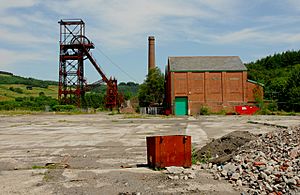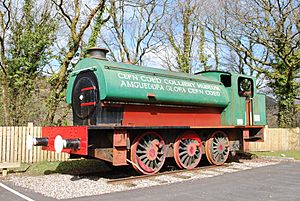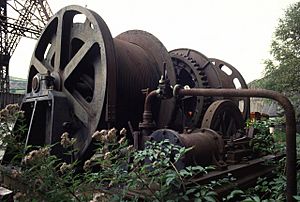Cefn Coed Colliery Museum facts for kids

Cefn Coed Colliery
|
|
| Lua error in Module:Location_map at line 420: attempt to index field 'wikibase' (a nil value). | |
| Location | Crynant, Neath Port Talbot, Wales |
|---|---|
| Type | Mining museum |
| Owner | Neath Port Talbot County Borough Council |
The Cefn Coed Colliery Museum is a fascinating place that used to be a real coal mine. Now, it's a museum where you can learn all about coal mining. It's located in a village called Crynant, near Neath in the South Wales Valleys in Wales.
The Story of Coal Mining in Neath
Coal mining has been important in the Neath area for a very long time. It started way back in the 1500s when the port of Neath began to grow.
In 1743, a man named Herbert Mackworth started mining coal in a place called Onllwyn. Mining became even bigger when the Neath and Brecon Railway opened in 1864. This railway made it much easier to transport coal.
Later, in 1872, David Bevan opened a new mine at Blaendulais. He called it the Seven Sisters mine, named after his seven daughters. His family, the Evans-Bevan family, became very involved in coal mining. By 1947, when the mines were taken over by the government, they owned seven mines close to each other.
History of Cefn Coed Colliery
Cefn Coed Colliery was opened in the 1920s by the Llwynonn Colliery Company. It was an anthracite mine. Anthracite is a very hard and shiny type of coal that burns cleanly.
It was very difficult to dig the mine shafts at Cefn Coed. The ground was made of very hard rock called Blue Pennant sandstone. It wasn't until a bigger company, the Amalgamated Anthracite Combine, took over in 1926 and invested a lot of money that they finally broke through the rock. The first coal was brought up from the mine in 1930.
The coal from Cefn Coed was high-quality anthracite. The best coal came from the deepest part of the mine, called the Big Vein, which was about 750 yards (or 685 meters) deep. Cefn Coed was one of the deepest anthracite mines in the world, going down more than 2,500 feet (about 800 meters). Other coal layers, or "seams," worked at Cefn Coed included Peacock, White Four Feet, and Nine Feet.
Mining at such great depths was very dangerous. Miners faced risks from methane gas explosions and falling rocks. Because of these dangers, the mine was sometimes called "The Slaughterhouse" by the miners.
By the end of World War II in 1945, there were 908 men working at the mine. In 1947, the mine became part of the National Coal Board, which was run by the government. Even with new investments, it was hard to keep the mine running safely and efficiently at such extreme depths. The number of workers started to decrease in the 1950s, and the mine finally stopped producing coal in 1968.
Many of the miners from Cefn Coed moved to a newer, shallower mine called Blaenant. One of the shafts at Cefn Coed was still used to help with air circulation (ventilation) and as an emergency exit for Blaenant until that mine closed in 1990.
The Museum Today

Today, you can still see most of the original buildings and equipment above ground at the Cefn Coed Colliery Museum. The huge steam engine that used to pull the cages up and down the mine shaft is still there. It was made in 1927 and is now powered by electricity.
This amazing engine, called the Worsley Mesne steam winding engine, sits in the old boiler house. It has two large cylinders and a drum that is 10 feet (about 3 meters) wide. This drum held two strong ropes, each over 800 yards (about 730 meters) long. These ropes were incredibly strong, able to hold up to 234 tons! They were checked every day and replaced completely every two and a half years to make sure they were safe.
While visitors can't go underground into the actual mine workings, the museum has a special "simulated gallery." This is a safe and accessible area that looks and feels like a mine tunnel, so everyone, including blind and disabled visitors, can experience what it was like.
Besides mining tools and equipment, the museum also has a unique restored tram that ran in Neath until 1920. The Cefn Coed Colliery Museum is an important part of the European Route of Industrial Heritage, which connects important industrial sites across Europe.


